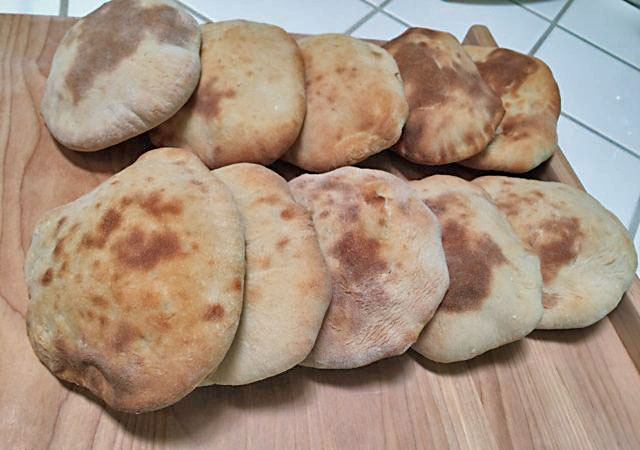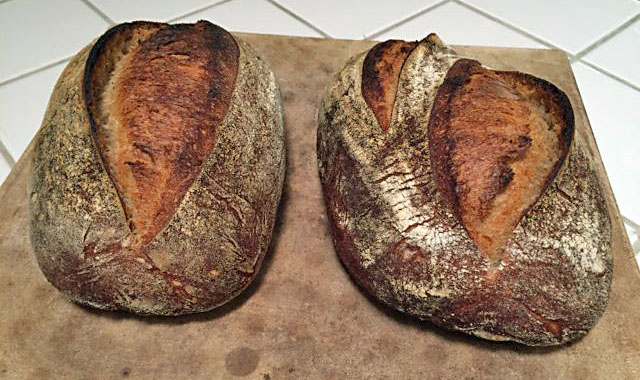
We like hummus and generally buy it "homemade" at a neighborhood Armenian deli. We also buy the pita bread they sell, which is made locally but not in the deli. It's sold in plastic bags, six to a bag. It's not terrible.
I recently checked an Israeli cookbook out of the library. It had a recipe for pita, not the first I had seen, but the book made a big deal about the superiority of fresh-baked pita over the kind I had been buying. So I made a batch.

Know what? Fresh-baked is better! In fact, home baked is better than store bought, even after freezing and thawing. Why should I be surprised?
I am not posting the recipe, because I am not convinced what I baked cannot be improved upon. Stay tuned.
Yesterday, I baked a couple 1kg loaves of sort of Ken Forkish's "Overnight Country Brown." The only "overnighting" was cold retardation of the formed loaves. And, rather than boules baked in cast iron Dutch ovens, I made bâtards, baked in my usual manner, on a baking stone with steaming via ice cubes dripping onto pre-heated lava rocks. I'm posting the photos just to remind us that the DO method, while producing wonderful loaves isn't the only way to do so with the Forkish (or Chad Robertson) formulas. These loaves have a delicious crunchy crust and tender crumb. Wonderful whole wheaty flavor with mild tang.


Between this bread with 30% WW and the Forkishish Pain de Campagne I make with WW and whole rye, it's hard to choose a favorite. They are both so good!
Happy baking!
David
- dmsnyder's Blog
- Log in or register to post comments
hello david,
first time im posting a comment on the fresh loaf. being from Israel i can also verify that the fresh baked pitta is indeed superior, especially the Yemenite pittas which are thick, airy and soft. by looking at the picture of you pittas i can see they are are more chewy and crispy on the outside, witch is more like a Moroccan "frena" bread. for hummus a softer crust is usually used, with the trick being putting the baked pittas under a towel right after baking so the crust softens.
for your enjoyment Ive added a link to a video of a Yemenite grandmother making pittas. love the way she handels the dough with such skill.
part 1
https://www.youtube.com/watch?v=xLhP_IWLjq8
part 2
https://www.youtube.com/watch?v=xLhP_IWLjq8
etamar
Welcome to TFL, etamar! And thank you for your comments.
The book from which I took the pita recipe had recipes for 3 kinds of pita, including the Moroccan one. The instructions for the one I made included covering the pitas with a towel, and I did that. The crust stayed somewhat soft, but that wasn't the biggest issue. I baked them on a baking stone in a very hot oven, without turning them over. All but one of the 10 pitas puffed up. The tops were almost paper thin. The bottoms were about 3mm thick and were chewy. I enjoyed the pitas, but I don't think they were just right.
I wondered if I should turn them over half-way through the bake. Would they be better cooked in a very hot cast iron pan than in the oven? What about baking in a steamed oven? Would that inhibit puffing up? Would it result in the desired softer crust?
Thanks for the links! I'm off to watch the videos now.
David
P.S. Why don't you introduce yourself to the TFL community and tell us something about what you like to bake, about breads in Israel or whatever you think would be interesting?
thank you david!,
i would very much like to start posting here, for which i would like to first take some photos of my recent bakes as i had not photoed my breads in a long time.
as for the pitta baking method, the best way to bake pitta is in an electric griddle pot that is found in Israel that dosent really have a name. you'll see it in the video in part two.
etamar
Yes! I saw the "griddle pot" and wondered about it.
I wonder about baking pita on a steel pizza stone (which I have) with the broiler element on, then covering the pitas with a damp towel to soften them.
Several experiments are possible.
Meanwhile, your linked videos exposed a myriad of others that could keep me fascinated for many hours!
David
first of all, im glad you found the videos interesting. if you have any questions regarding what you saw in the video, feel free to ask. as for the baking method you suggested, i think the broiler might be too hot and burn the top of the pittas as a result . how about preheating with the broiler on and turning it off in the beginning of the bake itself?
also, you have given me the encouragement to upload my first blog post just now, so thanks for that!
etamar
and a thicker bottom even if flipped half way though. I wanted to get it to split down the middle and then I saw a post somewhere, can't remember, and the trick was to put the bread on the stone for 10 seconds only then flip it over to get a more even top and bottom. Works for me, although sometimes not perfectly even, it is still way better than one sided or flip half way pita baking on a stone.
That might work. I have checked out a whole cookbook on flatbreads. Might learn a thing or two.
David
oops, here is the correct link for part 2: https://www.youtube.com/watch?v=2xYcXrZJ6mE
etamar
David,,
Really nice looking breads. How much steam time do you get from ice cubes?
Phil
My oven retains steam really well, if not on convection settings. I do tend to steam for more time before taking my apparatus out of the oven when I am baking larger loaves, and the longer I plan on steaming, the more ice I put in the perforated pie tin. For baguettes I am going to bake in 20-22 minutes, I steam for 12 minutes. For larger loaves that will bake in 30 minutes or longer, I steam for 15 minutes. Remember, steam provides no real benefit once the crust starts to firm up. Longer steaming results in an excessively shiny crust, which I do not find attractive.
Note that rye bread baking is a different animal.
David
I envy you. My Blue Star oven vents steam too well, although I have gotten surprisingly good oven spring at times (perhaps it would have been stupendous in your oven). I'm just wondering how long you find the cubes last, since that might extend my steam period.
I pre-heat my oven with the lava rocks in a cast iron skillet. So, when I put the tin with ice cubes on the lava, the ice melts very fast - maybe 30 seconds. The effect lasts because of my oven.
It sounds like you have a gas oven. They are a real challenge to the bread baker. I have never had a gas oven, but, from reading discussions here, it seems like the best solution is to cover the loaves with a stainless steel bowl or catering tray cover for the first part of the bake. There are some other methods that work but maybe not quite as well.
Use the TFL search box and search for "oven steaming." You will find many discussions.
David
Okay, so no longer than my hot water. Yes, I've exhaustively searched for a better method, and haven't had any success. Dutch ovens have usually burned the bottoms. I've purchased a Lodge trivet, which might help.
David
What is the name of the Israeli cookbook. Your breads always look great.
I am embarrassed to say I cannot recall which of the several Israeli cookbooks I have checked out had the pita recipe. But I can tell you for sure it was the book with pita recipes on pages 84 and 85!
Thanks for the compliment!
David
Your breads are always so beautiful. Admiration. Jealousy. Admiration....
David, those loaves are superb as always. I like the open crumb and they must taste wonderful, judging just by looking the picture.
Well done and happy baking, Joze
Hi David, I don't write here often, but I do enjoy reading your and other's posts. I wanted to share a few tips in addition to those given by itamar.
I think that a good pita should have almost no chew. The interior should be quite like that of a high hydration bread or Neapolitan pizza's rim, with the same irregular open structure. The crust should be thin and soft, mostly pale, with browned spots.
To achieve this you need to minimize dehydration while baking. Short bake, moist air and high heat are keys. Both a hot pan (covered while baking) or a pizza stone + steam are great options.
Do not roll the dough balls too thin, since you want to keep the air inside. I'd rather use the hands and not a rolling pin. They might not form a very distinct pocket, but that's really is OK.
Once baked, the breads should be always covered, other wise they will quickly turn chewy. Also, make sure to serve them warm, as their flavor and texture can only shine when warm.
I'd use anywhere from 60 to 70% hydration, the ideal amount is up to your baking temp, so that the interior bake before a thick crust is formed.
Last tip, if you plan on freezing them, sprinkle the pita with water before reheating (a minute of microwave zapping works best).
Sorry for the long post, I just think that pita breads haven't got the attention of modern "artisan" bakers, and that existing recipes can be improved.
Happy baking,
Shai
Those tips are wonderful. I can use them all next time I make pita. In fact, you have inspired me to do so sooner! I will print your reply and staple it to my recipe.
FYI, the way I have thawed pita is to wrap one or two in wax paper and zap them at full power in the microwave for 10 seconds. They come out warm and soft.
David
I'm glad to be of aid, and will be eager to so the results.
It seems your microwave is much stronger than mine, in 10 seconds I'll still have them frozen solid :)
A good problem to have. Well done and happy baking David
It's a happy problem, indeed.
David